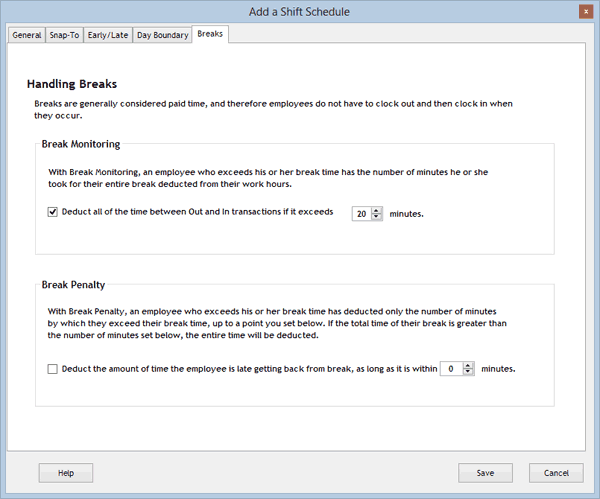
How do you handle breaks?
Work breaks are generally considered paid time, and therefore employees do not
have to clock out and then clock in. But there may be times when
you want to monitor employees' breaks to ensure they aren't taking extra time,
or even penalize employees who take longer breaks than they should. These functions are set up
when you add or edit a shift schedule (TimePilot Central > Setup menu > Shift
Setup).
Note: To use these functions, employees must clock out when they start their break and clock back in when they end their break.

There are two levels available, Break Monitoring and Break Penalty:
With Break Monitoring enabled, if an employee clocks out and back in within the number of minutes specified for their break time, the two transactions are recorded and labeled as breaks, which causes the software to ignore them when it calculates the employee's work hours. If the employee exceeds his or her break time, the transactions are recorded as normal out and in transactions. To use this function, click the checkbox in the Break Monitoring box and enter the number of minutes for your break.

If you just want to keep track of paid employee breaks and not penalize employees if they if they go over by a few minutes, set the number of minutes to a length of time greater than the break time, but be sure to keep that number of minutes fewer than you allow for lunch.
Example, using the same employees as in the examples at left:
You set the Break Monitoring time period to 20 minutes. The employees clock out at the start of their break and clock back in 12 minutes later. They took 2 extra minutes on break, but because they kept the time to less than 20 minutes, here's what will happen:
For more tips, click here.
Example #1:
Your employees get a paid 10-minute break each morning, so you set the Break Monitoring time period to 10 minutes. The employees clock out at the start of their break and clock back in 9 minutes later. Here's what will happen:
Example #2, using the same situation:
Your employees clock out at the start of their break and clock back in 12 minutes later. They took 2 extra minutes on break, so here's what will happen:
You might want to continue to pay employees for their breaks and only penalize them for the extra time they take. Break Penalty works with Break Monitoring, allowing you to do this. Here's how to set up this function:
An example:
As in the previous examples, your employees get a paid 10-minute break each
morning. You want to give them a 10-minute period during which they are only
penalized the number of minutes they are late returning from break; if they are
more than 10 minutes late, their transactions will be recorded as normal out and
in transactions, resulting in the deduction of the break time plus the excess
time they were gone. To do so, you set your Break Monitoring to 10 minutes and Break
Penalty to 20 minutes. Here's what will happen: